Abstract
The integration of advanced nuclear technologies like the System-Integrated Modular Advanced Reactor (SMART) offers a transformative approach to enhancing grid reliability in developing countries. This study focuses on the Nairobi distribution network in Kenya, a critical region characterized by an evolving energy mix of geothermal, hydro, solar, and wind power sources, comprising 220 kV and 132 kV transmission lines feeding 66 kV, 33 kV, and 11 kV distribution lines to various load centers. Using ETAP 22 simulation software, the research evaluates the impact of SMART integration through three scenarios: baseline operation, grid compensator-only operation, and SMART-SMR integration. Key reliability indices such as the System Average Interruption Frequency Index (SAIFI), System Average Interruption Duration Index (SAIDI), and Expected Energy Not Supplied (EENS) were analyzed. Results reveal that integrating a 100 MW SMART reactor reduces SAIDI by 2.8% (5.0433 h/customer-year) and SAIFI by 5.1% (0.0516 interruptions/customer-year), while maintaining voltage profiles within 98.21–98.91% of nominal. This analysis bridges gaps in prior research by demonstrating SMART’s ability to stabilize power grids in emerging economies, providing critical insights for policymakers aiming to achieve reliable and sustainable energy systems.
1. Introduction
Ensuring a stable, reliable, and clean energy supply is crucial for developing countries towards achieving economic and technological growth. Kenya faces the challenge of expanding and improving its power infrastructure to meet the growing energy demand while ensuring voltage stability, minimizing failure rates, and maintaining a reliable power supply. The Nairobi distribution network reflects these challenges due to its complex energy mix comprising geothermal, hydro, solar, and wind power. Despite electricity access having significantly improved from 30% in 2013 to over 75% in 2023 [], the city still faces numerous power failures from the grid. The Nairobi power distribution network includes 400 kV, 220 kV, and 132 kV transmission networks coving over 7676 km with 66 kV feeder lines, a 33 kV and 11 kV distribution medium-voltage network, and ultimately 415–450 V low-voltage lines supplying power to various load centers, according to Kenya’s Least Cost Power Development Plan (2022–2041) [].
Despite these developments, maintaining voltage stability and reducing failure rates remain critical challenges for Kenya’s power grid. The integration of advanced nuclear technologies, such as the System-Integrated Modular Advanced Reactor (SMART), offers a transformative opportunity to address these issues. SMART reactors, with their advanced load-following capabilities, reactive power support, and frequency response characteristics, are uniquely suited for realizing reliability of power grids in developing regions []. However, integrating new nuclear technologies into developing grids is not without complexity. It requires careful analysis to ensure that the addition of SMART-SMR enhances rather than compromises grid reliability.
This study focuses on evaluating the impact of a 100 MW SMART reactor on Kenya’s Nairobi distribution network. Using ETAP 22 simulation software, three scenarios were modeled: a baseline scenario representing current operations, a compensator-only configuration, and a configuration incorporating SMART-SMR integration. The analysis employed key reliability metrics such as the System Average Interruption Frequency Index (SAIFI), System Average Interruption Duration Index (SAIDI), and Expected Energy Not Supplied (EENS). These metrics and steady-state voltage and frequency analyses provide a comprehensive assessment of SMART’s potential to enhance Kenya’s grid reliability [].
This research fills critical gaps in existing literature by addressing the underexplored integration of nuclear technologies into power grids in developing nations. While previous studies have extensively examined renewable energy integration, the role of modular nuclear reactors remains insufficiently studied, particularly in the context of Kenya. By focusing on Nairobi County, this study also acknowledges its geographical limitations, emphasizing the need for further research to explore broader applications across the national grid. Additionally, the reliance on steady-state simulations highlights an opportunity for future work to incorporate transient and dynamic analyses.
The remainder of this paper is structured as follows: Section 2 provides a comprehensive literature review on distribution system reliability assessment and SMART technology. Section 3 details the methodology, including data preparation, simulation scenarios, and analysis. Section 4 presents the results of the simulations and discusses their implications. Finally, Section 5 concludes the study, summarizing key findings and offering recommendations for future research and policy considerations.
2. Literature Review
2.1. Reliability Assessment Methods
Reliability assessment of distribution systems employs various methodologies, categorized into analytical and simulation approaches. These methods are crucial for evaluating the impact of integrating advanced technologies, such as SMART-SMR into existing power grids. Analytical approaches, such as the Network Equivalent Approach (NEA), involve mathematical modelling of the system and the calculation of reliability indices based on component failure rates and repair times []. These methods are efficient and provide deterministic results. However, they may fail to capture complex system uncertainties in real-world distribution networks, especially when considering the integration of innovative technologies like SMART reactors.
Simulation methods, equally, employ techniques like Monte Carlo simulation to model system behavior over time. These approaches can account for the stochastic nature of component failures and repairs, providing a more realistic representation of system performance []. Ahmad et al. (2017) demonstrated the application of ETAP software for reliability analysis, which combines both analytical and simulation approaches []. This hybrid approach offers a balance between computational efficiency and the ability to model complex system dynamics, making it particularly suitable for assessing the impact of integrating advanced nuclear technologies into existing grids []. The choice between analytical and simulation methods often depends on the grid’s complexity, available computational resources, and the analysis objectives.
2.2. Global and Regional Studies on Reliability
Globally, extensive research has focused on reliability assessments of distribution networks integrating renewable energy sources and distributed generation (DG) []. Studies have demonstrated the effectiveness of DG in enhancing grid stability, but challenges remain, including voltage regulation and fault management in complex networks. Kenya’s energy landscape presents unique challenges and opportunities, as its electricity mix combines renewable energy and emerging nuclear technologies. However, the literature on nuclear reactor integration, particularly SMART, in developing grids remains limited.
Ahmad et al. (2017) demonstrated the successful use of ETAP for reliability analyses in various grid configurations, highlighting its adaptability to emerging technologies []. Similarly, studies on distributed generation reliability by Idowu et al. (2021) underline the importance of integrating advanced models to reflect real-world complexities []. Despite these advances, research in Kenya has primarily focused on renewable energy integration, with limited emphasis on the role of modular reactors like SMART. This study bridges that gap by evaluating the reliability implications of SMART integration into Kenya’s Nairobi distribution network.
2.3. Systems Reliability Indices
The assessment of power distribution reliability employs three main concepts to evaluate grid reliability at individual load points, formulated as []:
where λi represents the load point failure rate, i, and ri is the load point restoration time in minutes i.
Key reliability indices are calculated using the ETAP 22 simulation software. The primary indices utilized are formulated as;
- The System Average Interruption Frequency Index (SAIFI) quantifies the average number of sustained interruptions experienced by customers annually. Lower SAIFI values indicate higher reliability [].
- 2.
- The System Average Interruption Duration Index (SAIDI) represents the average total outage duration per customer annually, where reduced values signify shorter outages [].
- 3.
- The Customer Average Interruption Duration Index (CAIDI) measures the average restoration time for sustained interruptions, reflecting the utility’s service efficiency [].
- 4.
- The Expected Energy Not Supplied (EENS) estimates the total energy lost due to service interruptions, with lower values indicating minimal energy wastage.
2.4. SMART Load-Following Techniques
This study highlights the load-following capabilities of SMART as a critical feature for enhancing grid reliability. SMART’s electrical output characteristics demonstrate its adaptability to fluctuating grid demands, ensuring a stable power supply. As detailed in Table 1 SMART has a reactor thermal output of 330 MWth, which translates to a gross electrical output of 100 MWe and a net output of 90 MWe. The load-following capabilities of SMART are primarily achieved through its electrical systems, particularly the turbine-generator set. The generator, rated at 111 MVA with an active power output of 105 MW and a voltage of 18.0 kV, plays a crucial role in this process. The turbine, operating at 1800 rpm and 60 Hz, allows for rapid adjustments in electrical output, ensuring seamless integration with the grid under varying load condition [].

Table 1.
SMART-SMR electrical parameters [].
While the reactor thermal output remains constant at 330 MWth, the SMART-SMR can adjust its electrical power output to provide flexibility for grid reliability. The plant’s high availability target of >95% indicates its reliability in maintaining a consistent power supply [].
The implementation of advanced control algorithms in SMART electrical systems, including the turbine governor and generator excitation system, allows for precise control of electrical output. These systems work in tandem to manage the conversion of the constant thermal energy into variable electrical output as required by grid conditions [].
The contribution of SMART-SMR reactors to grid stability is characterized by inertial response, which is typically modelled using the swing equation:
where H is the inertia constant, usually ranging between 5 and 7 s for SMRs. Ω is the angular velocity of the rotor, t defines time, Pm is the generator’s mechanical power input, and Pe denotes the generator’s electrical power. The inertial response is crucial for maintaining grid frequency stability during sudden load changes [].
Primary frequency control in SMART-SMR follows the relationship ΔP = −K × Δf, where K, the governor gain, typically ranging from 20 to 25, allowing a 5% power change (P) for every 0.1 Hz frequency deviation, enabling rapid response to grid frequency fluctuations. The reactors also offer dynamic reactive power support, enhancing voltage stability. Reactors enhance voltage stability by dynamically managing reactive power (Q). The relationship for complex power is represented by:
where: S is the complex power in volt-amperes (VA), combining real power (P) and reactive power (Q). P is the real power in watts (W), representing the actual energy consumed by the load. Q is the reactive power in VAR, representing energy oscillating between the source and reactive components (like capacitors and inductors). V is the RMS voltage. I = ∣I∣e−jθI is the complex conjugate of the current ensures proper calculation of active and reactive power contributions in the system.
The reactive power capability is expressed as
where S is the apparent power (111 MVA for SMART), and P is the active power. As the SMART reactor increases its active power output (P), its available reactive power (Q) decreases, and vice versa, as shown in Figure 1. At maximum active power output, the reactor has minimal reactive power capability. When producing no active power, the reactor can provide maximum reactive power since the reactor can operate in both over-exited and under-exited generators as demonstrated in the power quadrant below [].
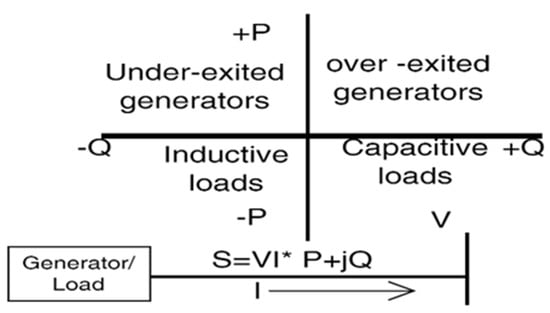
Figure 1.
Power quadrant [].
The SMART reactor can operate in both the over-excited generators and under-excited generators quadrants. In the over-excited state, it produces positive reactive power (+Q), helping to raise system voltage. In the under-excited state, it absorbs reactive power (−Q), helping to lower system voltage. This capability allows SMART reactors to contribute significantly to voltage regulation in the grid [].
3. Methodology
This study employed a three-phase methodological framework: data preparation, scenario modeling in ETAP 22, and comparative analysis. The approach is designed to evaluate the reliability and performance impacts of SMART-SMR integration on the Nairobi distribution grid. The input data, including the buses, load centers, transformers, and failure rates and repair time. The data consists of historical network performance data from 2019 to 2023, focusing on load profiles, failure rates, and repair times []. The simulation phase creates detailed models of the existing network and proposed SMART integration scenarios. The load flow analysis module for the steady-state reliability assessment module for calculating reliability indices was simulated. The comparative analysis phase evaluates the scenarios based on key performance indicators, including voltage profiles, frequency stability metrics, and reliability indices, as shown in Figure 2.
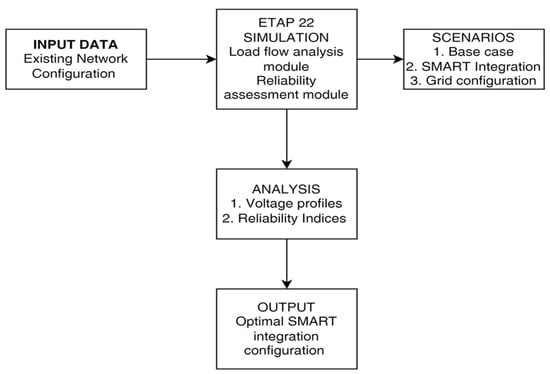
Figure 2.
The conceptual framework for the study.
3.1. System Scenario Modelling
The network topology and component specifications modelled were sourced from the latest grid expansion plans and KPLC’s asset management system. Specific reliability parameters were collected for key system components: transformers (seven units, two-winding type) with active failure rates of 0.015 f/yr and mean time to repair (MTTR) of 200 h; circuit breakers (34 units, both HV and LV types) with active failure rates of 0.004500 f/yr and MTTR of 50 h; and generators, including the SMART reactor (modelled as a synchronous generator with a failure rate of 0.000000 f/yr), Olkaria II (failure rate 0.990 f/yr), and the grid interconnection point (U6 Compensator, failure rate 0.743 f/yr). The data from the Nairobi County distribution grid were used to create a detailed model of the existing 132 kV, 66 kV, and 33 kV networks, focusing on the critical load points in Nairobi County, as summarized in Table 2 []. The model incorporated 15 buses with varying failure rates (ranging from 0.001100 to 0.011000 f/yr) and MTTRs of 2 h, 7 transformers, and 15 lumped loads representing various sectors (commercial, industrial, residential, and governmental) with failure rates ranging from 0.005800 to 0.099000 f/yr and replacement times of 50 h. The data enabled the simulation of the network’s response under various operational scenarios.

Table 2.
Modelled data summary.
3.2. Modelling Assumptions
The distribution network model selected key areas rather than the entire county, utilizing a simplified representation of the 132 kV, 66 kV, and 33 kV Nairobi County distribution grid single-line diagram (Figure 3). The model assumes only AC systems, with all switching devices operating typically as required and capable of isolating faults to restore power to load points through appropriate switching actions and available alternative supplies. All failures were treated as statistically independent, with the possibility of considering second-order faults. The analysis was limited to steady-state conditions and did not account for transient phenomena. The simulation employed IEEE Standard 1366-2012 [] for calculating key reliability indices and analytical methods based on the minimal cut set approach for system reliability analysis, adhering to IEEE 493 standards Load flow calculations followed IEC 60909 standards [].
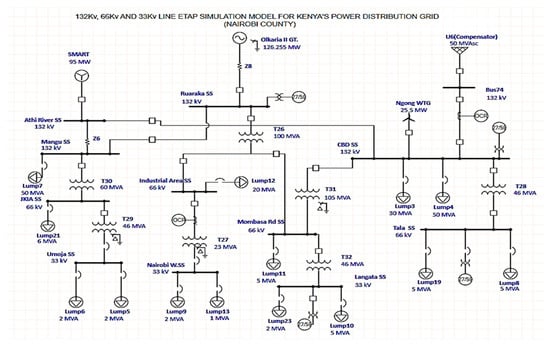
Figure 3.
Modelled Nairobi County distribution grid single-line diagram.
3.3. Scenarios Modelled
- Base case: No SMART-SMR Unit
The base case scenario modelled the existing distribution system without the proposed SMART reactor, represented by an open high-voltage circuit breaker. Power is supplied from three primary sources, namely, the Olkaria II geothermal plant (126.255 MW), a compensator network (50 MVAr grid connection), and the Ngong WTG (25.5 MW wind turbine), as shown in Figure 4 below. This configuration incorporates a mix of conventional and renewable energy sources, establishing a baseline for evaluating the potential impact of integrating the SMART reactor. The model assumes constant load demands at the buses during peak hours to facilitate the effective calculation of system indices.
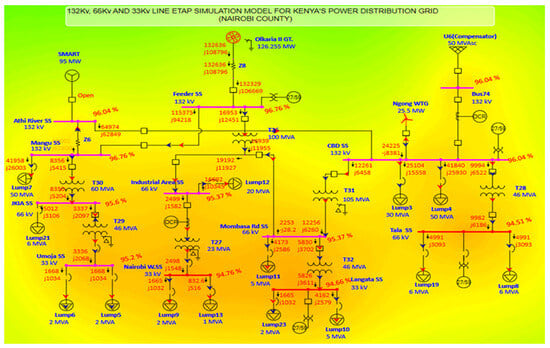
Figure 4.
Base case scenario.
- 2.
- Scenario 2: Wind and Compensator providing power
In this scenario, the distribution grid operates solely with the Ngong Wind Turbine Generator (WTG) and the compensator providing power from the grid. The model shows the Ngong WTG and the U6 (Compensator). The circuit breaker connecting the Olkaria II GT is open, indicating its exclusion from this scenario. The SMART-SMR unit is also disconnected with the open high-voltage circuit breaker (Figure 5). This configuration aims to evaluate the grid’s performance and stability when relying primarily on wind power and grid compensation, without the geothermal source or the proposed SMART-SMR. The scenario helps determine the level of compensating power required from the grid to adequately meet the energy demand across various load centers, particularly during periods of variable wind generation [].
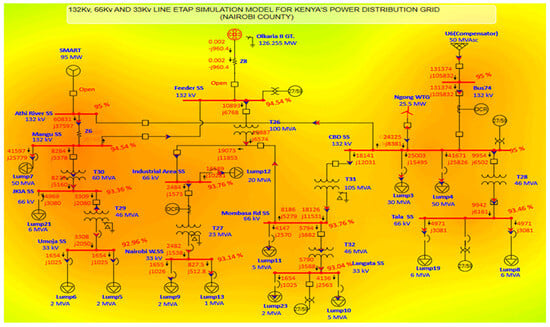
Figure 5.
Scenario 2 modelling.
- 3.
- Scenario 3: SMART-SMR Integration with existing power sources
This scenario models the integration of the SMART-SMR unit into the power distribution grid. In this configuration, the SMART-SMR is connected and actively supplying power to the network. The circuit breaker connecting it to the main grid is closed, indicating its full integration. This scenario also includes power generation from the Olkaria II GT geothermal plant and the Ngong WTG, creating a diverse energy mix. The U6 Compensator also remains connected to provide voltage support/regulation. This setup demonstrates a comprehensive approach to power generation, combining nuclear, geothermal, and wind resources to meet the electricity demand. The simulation, therefore, allows for the analysis of how the SMART-SMR affects overall grid stability, power flow, and voltage profiles across the various substations and load points in the 132 kV, 66 kV, and 33 kV networks.
3.4. Network Configuration with Protection Devices
The key protection devices used in the simulation included 33 circuit breakers with a typical failure rate of 0.004500 f/yr and MTTR of 50 h. Seven transformers (T26–T32) with failure rates of 0.015000 f/yr were also configured as per Kenya’s grid code.
4. Results and Discussion
4.1. Comparative Analysis of Scenarios
The reliability assessment of the simulated distribution network revealed significant variations across three scenarios: the base case (Scenario 1), compensator-only operation (Scenario 2), and SMART-SMR integration (Scenario 3). Scenario 3 demonstrates greater performance across all key reliability indices, as illustrated in Figure 6.
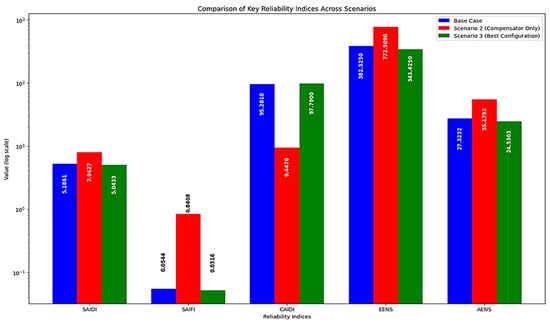
Figure 6.
Key reliability indices comparison.
The optimized configuration in Scenario 3 achieved a SAIDI of 5.0433 h/customer-year and SAIFI of 0.0516 interruptions/customer-year, representing improvements of 2.8% and 5.1%, respectively, over the base case, and 36.5% and 93.9% improvements over Scenario 2. This configuration also achieved the lowest Expected Energy Not Supplied (EENS) at 343.425 MWh/year, a 10.2% reduction from the base case, and a 55.5% reduction from Scenario 2. The Average Energy Not Supplied (AENS) was optimized at 24.5303 MWh/customer-year, showing similar improvements. The high ASAI of 0.9994 (equivalent to 99.94% availability) in Scenario 3 outperformed Scenario 2, further underscoring the enhanced reliability of this optimized setup.
Scenario 3, as shown in Figure 7 and quantified in Table 3, demonstrated significant improvements in voltage profiles across the distribution network following SMART integration. The simulation results revealed that bus voltages consistently operated near their nominal values, indicating enhanced power quality throughout the system. Table 4 shows the key reliability indices across the modelled scenarios. Industrial Area SS voltage improved to 98.84% of nominal, up from a base case of 93.76%. Similarly, Mombasa Rd SS operates at 98.91% of nominal voltage, while Langata SS, despite being on the lower 33 kV system, maintains 98.21% of nominal voltage. These results, spanning different voltage levels (66 kV for Industrial Area and Mombasa Rd SS, 33 kV for Langata SS), illustrate a narrow operational range of 98.21% to 98.91% of nominal voltages across the network. This consistency in high voltage levels across various substation categories suggests that SMART integration has a uniformly positive impact on voltage regulation throughout the network.
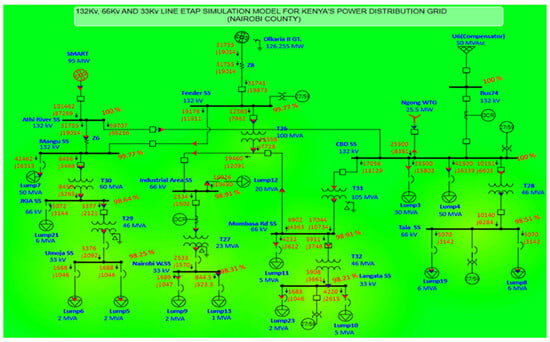
Figure 7.
Scenario 3 modelling.

Table 3.
Input and output data.

Table 4.
Modelled reliability indices results.
These improvements suggest reduced system stress and more efficient power distribution. Scenario 2 exhibited noticeably degraded performance across all metrics. Its SAIDI of 7.9427 h/customer-year and SAIFI of 0.8408 interruptions/customer-year represent increases of 53.2% and 1445.6%, respectively, compared to the base case. The EENS in this scenario escalated to 772.509 MWh/year, a 102% increase from the base case, while the AENS reached 55.1792 MWh/customer/year. The lower ASAI of 0.9991 further indicates reduced overall system reliability.
The results (Table 4) hence demonstrate that relying solely on a compensator-based power supply significantly compromises the grid’s reliability. The contrast between Scenarios 2 and 3 highlights the critical importance of maintaining a diverse and well-integrated power generation mix in ensuring grid reliability.
4.2. Reliability Enhancement
The integration of SMART technology (Scenario 3) significantly improved substation reliability across all voltage levels compared to the base case (Scenario 1) and compensator-only (Scenario 2) configurations. High-voltage substations (132 kV) showed the most substantial improvements, with failure rates decreasing from 0.032400 f/yr to 0.002410 f/yr for CBD SS and from 0.017500 f/yr to 0.000540 f/yr for Mangu SS. Medium-voltage substations (66 kV) also exhibited marked improvements, with JKIA SS’s failure rate reducing from 0.044200 f/yr to 0.007200 f/yr and Mombasa Rd SS from 0.030100 f/yr to 0.001100 f/yr. Low-voltage substations (33 kV) showed similar enhancements, with Umoja SS’s failure rate decreasing from 0.079510 f/yr to 0.002510 f/yr (Table 5). These improvements are attributed to the SMART advanced control systems, load-following capabilities, and ability to provide reactive power support, which enhances grid power quality while reducing stress on substation equipment.

Table 5.
Comparative failure frequencies for substation (SS) scenarios.
4.3. Impact of SMART Integration
The SMART reactor’s electrical power output showed more stability with less pronounced oscillations compared to Olkaria II GT, settling at a higher steady-state value of approximately 20 MW. This stability in power output, coupled with its ability to adjust between 20 and 100% of rated capacity, as mentioned in the literature review, showcases SMART-SMR’s flexibility in responding to grid demand fluctuations. The reactor’s rapid stabilization after initial disturbances aligns with the implementation of Model Predictive Control (MPC) algorithms, which can reduce power output fluctuations by up to 40% compared to traditional PID control methods.
The reactive power graph illustrates SMART-SMR’s superior voltage regulation capabilities, maintaining a higher reactive power output of about 25 MVAr compared to Olkaria II GT’s 15 MVAr. This aligns with the reactor’s dynamic reactive power support capability, modelled by equation 10, where S is 111 MVA for SMART. This enhanced reactive power control contributes significantly to voltage stability, as evidenced by the improved voltage profiles across the network, with substations like Industrial Area SS increasing from 93.76% to 98.84% of nominal voltage. Higher exciter current and voltage for SMART-SMR (3 pu and 2.8 pu, respectively) was found compared to Olkaria II GT (1.5 pu and 1.4 pu). Figure 8 further demonstrate its higher voltage regulation and power factor correction capabilities. These characteristics, combined with SMART-SMR’s inertial response (modelled by the swing Equation (9), and primary frequency control (ΔP = −K × Δf), contribute to the observed improvements in reliability indices, such as the reduction in SAIDI and SAIFI.
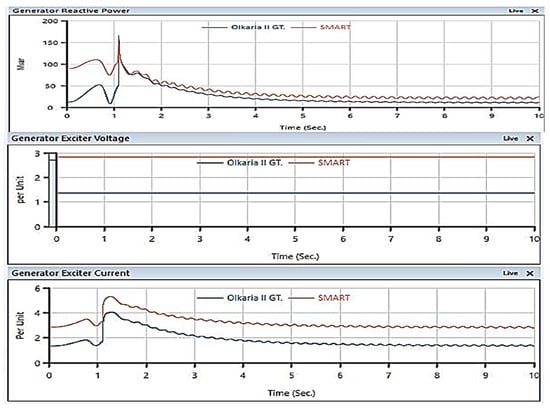
Figure 8.
Simulated power factor results.
4.4. Effects of Network Reconfiguration and Protection Devices
The optimal SMART-SMR integration configuration for the Nairobi County distribution network demonstrates significant improvements in system performance and reliability. Operating at 117.317 MW and providing 122.885 Mvar of reactive power support, the SMART-SMR enhances voltage stability and power factor correction across the network. This configuration results in improved voltage profiles, with key substations like Industrial Area SS and Mombasa Rd SS operating at 98.84% and 98.91% of nominal voltage, respectively. The integration leads to notable enhancements in reliability indices, including a 2.8% reduction in SAIDI to 5.0433 h/customer-year and a 5.1% improvement in SAIFI to 0.0516 interruptions/customer-year (Table 6). The SMART-SMR’s load-following capabilities, allowing output adjustment between 20 and 100% of rated capacity, coupled with its advanced control systems, contribute to a 10.2% reduction in Expected Energy Not Supplied (EENS) and maintain a high Average Service Availability Index (ASAI) of 0.9994.

Table 6.
Reconfiguration parameters.
5. Conclusions
This study evaluated the integration of System-Integrated Modular Advanced Reactor (SMART) technology into Kenya’s power grid, specifically focusing on the Nairobi County distribution network. The research aimed to evaluate the impact of 100 MW SMART reactor integration on grid reliability and stability. Using ETAP 22 simulations, three scenarios were analyzed: baseline operation, compensator-only operation, and SMART-SMR integration. The integration resulted in reduced SAIDI and SAIFI values, lower Expected Energy Not Supplied (EENS), and improved voltage stability across various substation categories. These findings suggest that SMART technology can effectively enhance grid performance and reliability in developing power systems.
The results of this study have important implications for energy policy and infrastructure development in Kenya and potentially other emerging economies facing similar grid stability challenges. Future research should focus on the long-term economic impacts of SMART-SMR integration, including potential reductions in energy costs and improvements in industrial productivity due to enhanced grid reliability. Additionally, investigating the scalability of this solution and its applicability in different geographical and economic contexts would be valuable. From a policy perspective, these findings provide a foundation to make strategic decisions for energy planning, potentially adapting regulatory frameworks to facilitate the adoption of advanced SMRs.
Author Contributions
Conceptualization, O.K.G. and C.-k.C.; methodology, O.K.G.; software, O.K.G. and C.-k.C.; validation, C.-k.C.; analysis and investigation, O.K.G.; resources, O.K.G. and C.-k.C.; data curation, O.K.G. and C.-k.C.; writing—original draft preparation, O.K.G.; writing—review and editing, O.K.G.; visualization, O.K.G. and C.-k.C.; supervision, C.-k.C.; project administration, O.K.G.; funding acquisition, C.-k.C. All authors have read and agreed to the published version of the manuscript.
Funding
This research was funded by the 2024 Research Fund of the KEPCO International Nuclear Graduate School and the 2023/24 National Research Fund NRF-2022M2C7A1A02064364, Republic of Korea.
Data Availability Statement
The original contributions presented in the study are included in the article. Further inquiries can be directed to the corresponding authors.
Acknowledgments
KEPCO International Nuclear Graduate School and 2023/24 National Research Fund NRF-2022M2C7A1A02064364, Republic of Korea have been instrumental in supporting this research project.
Conflicts of Interest
No conflict of interest has been raised. The funder had no role in the study design, data collection and analysis, writing, and results publication.
References
- Ministry of Energy. Kenya National Elecritification Strategy; Ministry of Energy: Nairobi, Kenya, 2018.
- Kenyas LCPDP 2022-2041 Sector Report Final 2022_31082022 (005). Available online: https://www.energy.go.ke/electrical-power-development-0 (accessed on 28 November 2024).
- IAEA. Nuclear Power Reactors in the World; IAEA: Vienna, Austria, 2018. [Google Scholar]
- Idowu, K.; Uhunmwangho, R.; Okafor, E.C.N.; Big-Alabo, A. Reliability Improvement Study of a Distribution Network with Distributed Generation. Appl. Model. Simul. 2021, 5, 53–65. [Google Scholar]
- Guimarães, I.O.; da Silva, A.M.L.; Nascimento, L.C.; Fotuhi-Firuzabad, M. Reliability assessment of distribution grids with DG via quasi-sequential Monte Carlo simulation. Electr. Power Syst. Res. 2024, 229, 110122. [Google Scholar] [CrossRef]
- Ahmad, S.; Sardar, S.; Asar, A.U.; Karam, F.W. Reliability Analysis of Distribution System using ETAP. Int. J. Comput. Sci. Inf. Secure 2017, 15, 197–201. [Google Scholar]
- Operation Technology Inc. ETAP 22.0: Electrical Power System Analysis Software Documentation; Operation Technology, Inc.: Irvine, CA, USA, 2023. [Google Scholar]
- IEEE Standard 1366-2012; IEEE Guide for Electric Power Distribution Reliability Indices. IEEE Power & Energy Society: Piscataway, MJ, USA, 2012.
- KAERI. Status Report 77-System-Integrated Modular Advanced Reactor (SMART); KAERI: Daejeon, Republic of Korea, 2011. [Google Scholar]
- Weedy, B.M.; Cory, B.J.; Jenkins, N.; Ekanayake, J.B.; Strbac, G. Electric Power Systems; Wiley: Hoboken, NJ, USA, 2012. Available online: https://books.google.ro/books?id=JkQdhXtGBtYC&printsec=copyright&rdir_esc=y#v=onepage&q&f=false (accessed on 28 November 2024).
- KPLC. Grid Development and Maintenance Plan 2016-17–2020-21; Nairobi City County 132kV-66kv-33kV—Distribution Grid Combined_20221207; KPLC: Nairobi, Kenya, 2021. [Google Scholar]
- IEC 60909; Short-Circuit Currents in Three-Phase A.C. Systems. Part 0, Calculation of Currents, 2.0. International Electrotechnical Commission: Geneva, Switzerland, 2016.
- Tiwary, A.; Tiwary, S. Evaluation of Customer Orientated Indices and Reliability Study of Electrical Feeder System Evaluation of Customer Orientated Indices and Reliability Study of Electrical Feeder System. Reliab. Theory Appl. 2020, 15, 36–43. [Google Scholar]
Disclaimer/Publisher’s Note: The statements, opinions and data contained in all publications are solely those of the individual author(s) and contributor(s) and not of MDPI and/or the editor(s). MDPI and/or the editor(s) disclaim responsibility for any injury to people or property resulting from any ideas, methods, instructions or products referred to in the content. |
© 2024 by the authors. Licensee MDPI, Basel, Switzerland. This article is an open access article distributed under the terms and conditions of the Creative Commons Attribution (CC BY) license (https://creativecommons.org/licenses/by/4.0/).